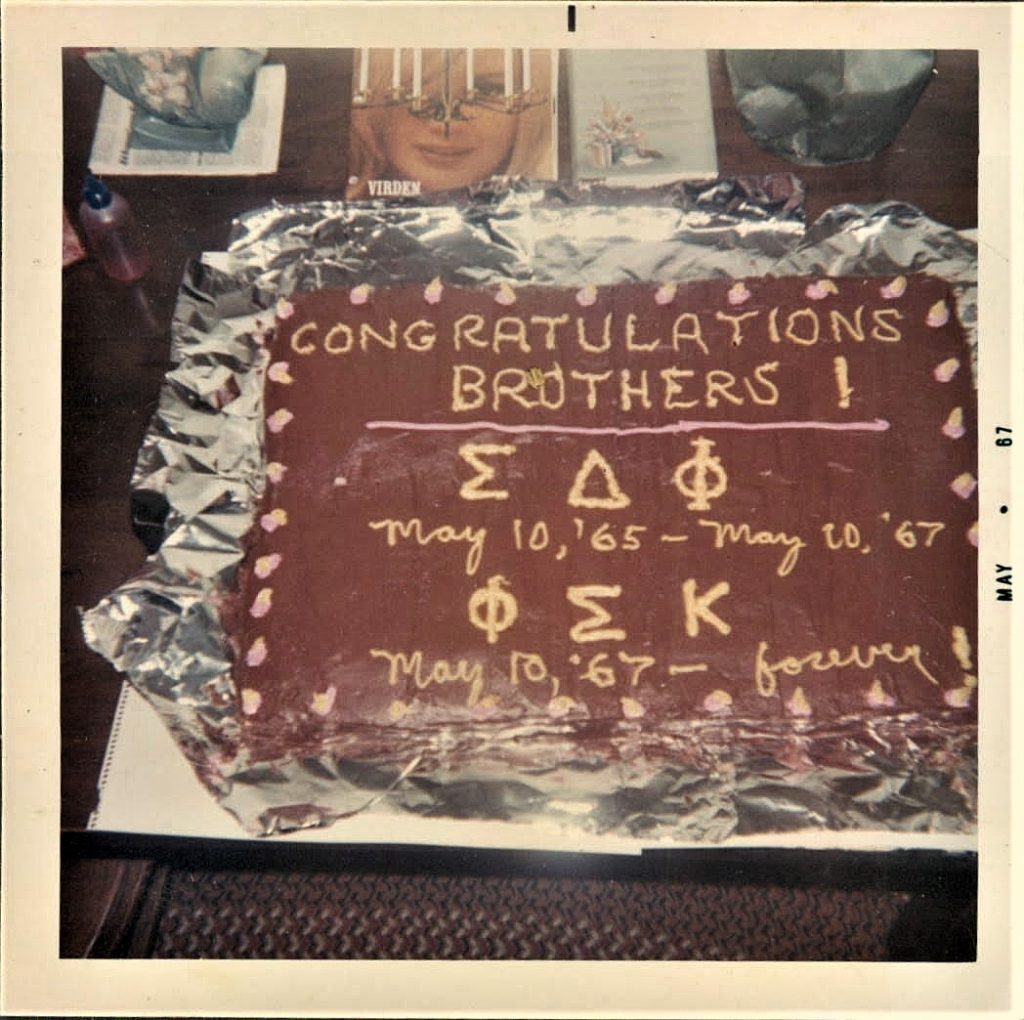
Pi Pentaton at Northern Illinois University
What eventually became the Pi Pentaton Chapter of Phi Sigma Kappa had its beginnings in the less serious designs of two separate groups of friends on the Northern Illinois University campus. Both groups contained men who were not impressed with the Greek System, but nevertheless wanted the experience of close camaraderie. One group, consisting of Edward Kelsey, Michael Dolan, William Lewis, and John Frithiof, took the name Gamma Omicron Delta Sigma (GODS), and even answered the telephone with the greeting: “Hello, Mount Olympus. Which of the GODS would you like to speak with?” The sister of Mike Dolan even lettered shirts with their Greek name for the men.
The second group, consisting of Kent Foster, Martin Gaspar, David Gulbrandsen, Richard Stevens, and Gregory Gudel formed for similar reasons, and at least some of them, went by the name Sigma Epsilon Chi (for SEX, of course). One, however, Dave Gulbrandsen, does not recall ever using that name, and insisted he was much too conservative for that. What appears to be the case, however, is that both groups chose Greek names because of their attempt at humor, and also as a means of displaying their critical feeling about the fraternities that then existed on campus. It wasn’t long, however, before the thoughts of some of the men turned to more serious plans to form a lasting organization. One of these, and perhaps the prime mover in the effort to create a recognized campus fraternity, was Kent Foster. That not all of his friends were as enthusiastic about his efforts, however, is demonstrated by an incident remembered by Martin Gaspar.
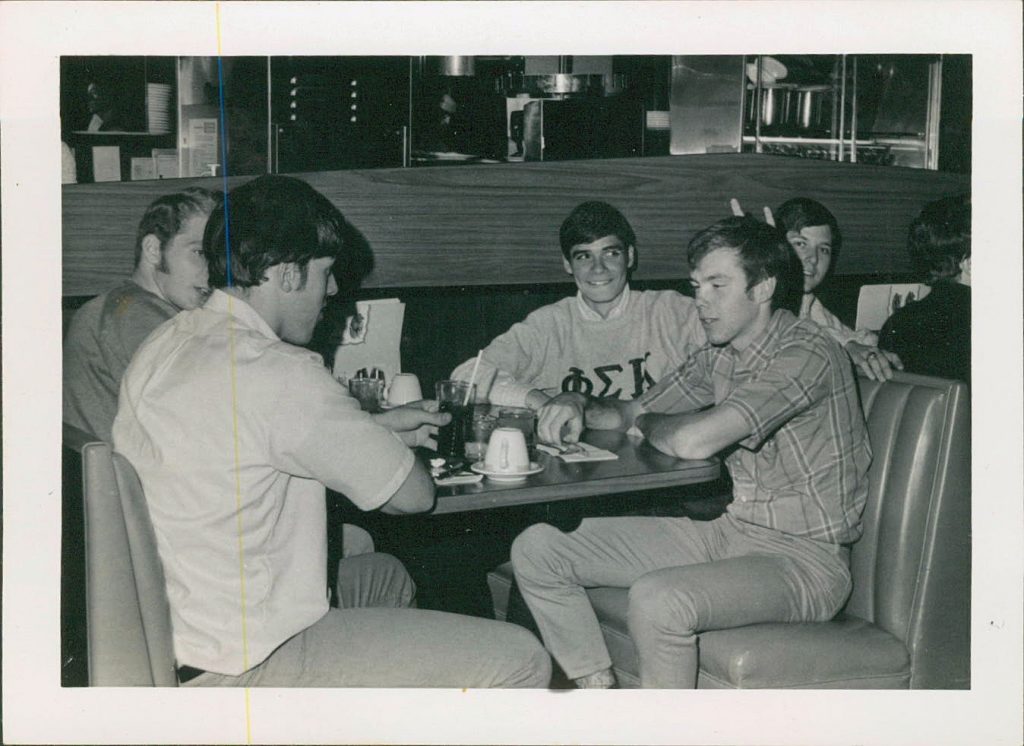
Somewhere along the way, a petition had to be presented to the university to gain recognition, and Kent Foster made the rounds of his friends’ dorm rooms to get them to sign. When he got to Marty’s room, late at night, and after Marty was already in bed, he found it difficult to get a serious response from someone who didn’t appreciate having his sleep interrupted—especially since Marty was not very keen on the idea of joining the campus fraternity system. Kent was insistent, however, arguing that he really needed Marty’s signature. Marty’s final response was a question. He asked: “If I sign this thing, will you let me get back to sleep?” With Kent’s assurance, Marty gave in, and Kent went on his way. As for the formal organization of a local fraternity, mutual friends in both of the groups mentioned above decided to combine their efforts. In April of 1965, representatives of both groups (Michael Dolan, William Lewis, Kent Foster, Edward Kelsey, and John Frithiof), met in room 380 of Douglas Hall to talk about forming a new fraternity.
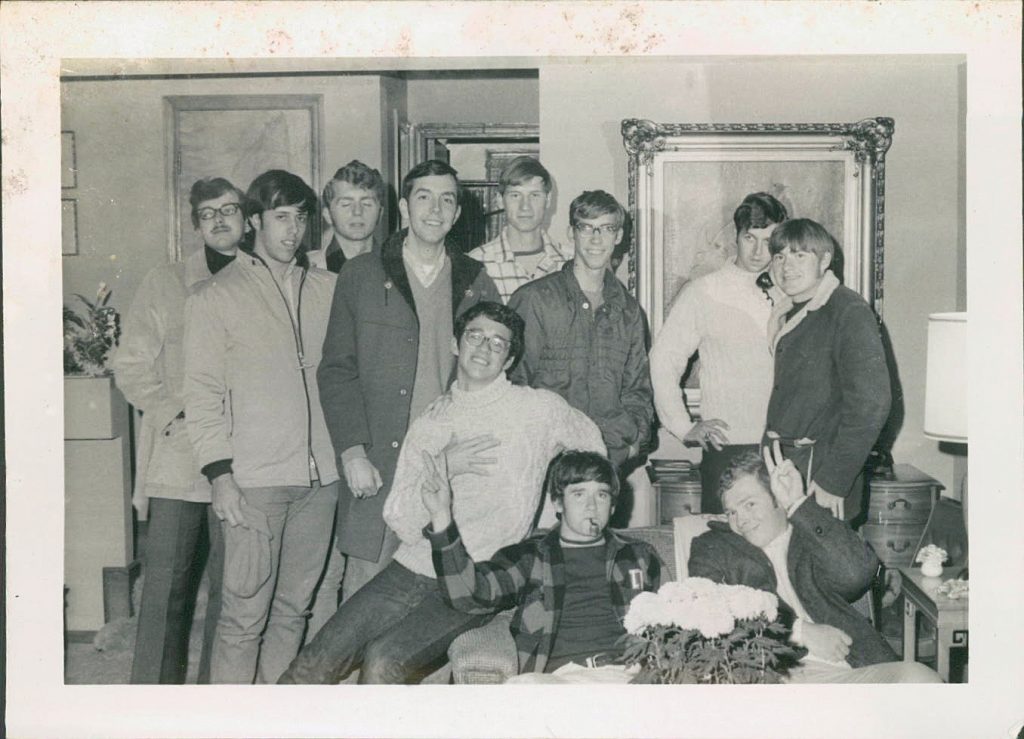
A second meeting attended also by David Gulbrandsen, Greg Gudel, Martin Gaspar, and Richard Stevens moved the process even further, and Foster, Stevens, Dolan, and Kelsey followed up by writing a formal constitution for the new fraternity. On May 10, 1965 (now considered the founding date of the local fraternity), the constitution was formally accepted by the entire group, which took the name Sigma Delta Phi. It is generally agreed that Kent Foster was the moving force behind these events, and he became the group’s first president. Foster, Gulbrandsen, Gaspar, Gudel, Kelsey, Lewis, Dolan, Stevens, and Frithiof were the original founders, and two faculty members were enlisted as advisers: K. L. Curtis, and P. Allen Dionisopoulos. The petition and constitution were submitted to the university, and on May 20, 1965, Sigma Delta Phi was given temporary recognition by the Student Association Board.
According to John Frithiof, the student vote on the board was split, but the presence there of Dr. Dionisopoulos swayed the faculty votes and determined the final positive result. Temporary recognition by the IFC followed on September 29, 1965. After the mandatory one-year on probationary status, both groups were granted permanent recognition. The members did not yet live together, but were scattered in different residential facilities—mostly Lincoln and Douglas dorms. The group attracted other men to it, and quickly established its own philosophy to set it apart from other campus fraternities. It was to be a fraternity recognizing diversity in its membership, mutual respect, a prohibition of hazing, and an interest in enjoyable social and athletic activities. While they didn’t win many trophies in their early years, Sigma Delta Phi was active on campus, and easily recognizable in the Greek Week Chariot Races, with their distinctive green chariot. New pledges also wore green beanies. With the eventual recruitment of a small group of men who called themselves “The Chiquitas,” a new and livelier spirit was introduced to the fraternity.
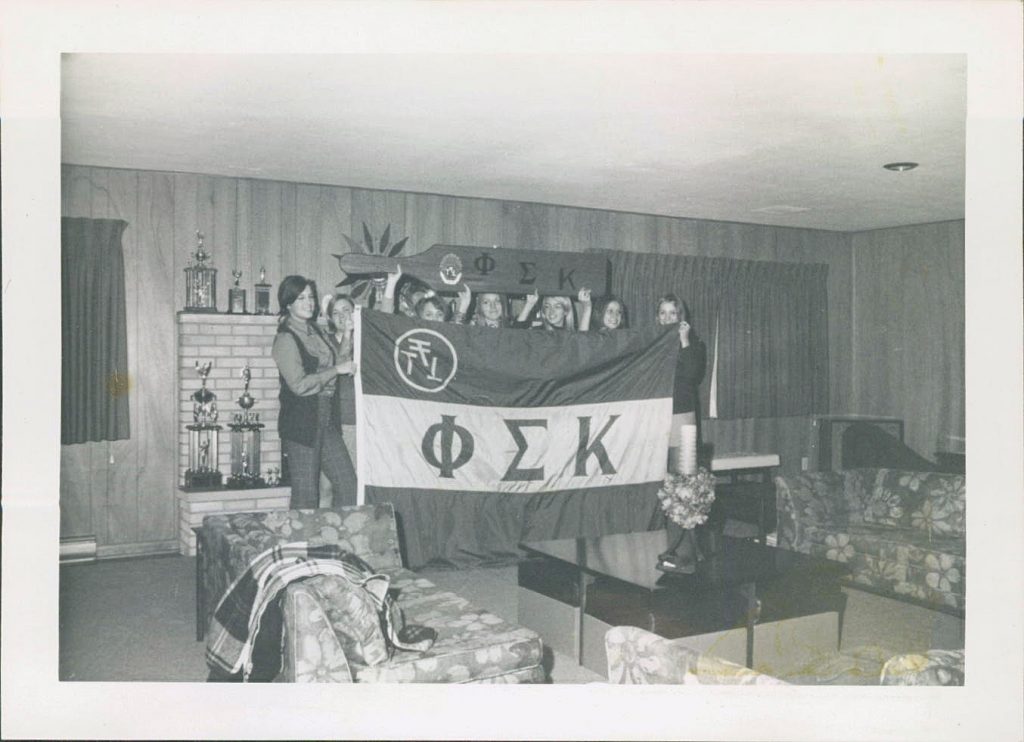
Recruitment of new men was a challenge, however, for a small group with no home and little money. Treasurer Frithiof recalls that for a rush party, they could only afford to buy doughnut holes because they didn’t have enough money for whole doughnuts. In the meantime, the campus administration was working with several local fraternities to explore the possibilities of expansion on the campus by national organizations. On March 25, 1965, Dean of Men H. E. Husa wrote Executive Director Bert Brown of Phi Sigma Kappa asking about the fraternity’s interest in NIU, and mentioned that one of the local fraternities on the campus had expressed an interest in Phi Sig. Bert responded on April 1, 1965 that “Phi Sigma Kappa is very definitely interested in the possibility of placing a chapter at Northern Illinois University.” In April, area volunteer officers reported to Bert that NIU was a “good prospect” for expansion, and Bert followed up by sending promotional information to Dean Husa. On May 13, 1965, Dean Husa sent a request to Bert asking that a field staff member visit the campus in the fall. The early part of the 1965-66 school year was a difficult one for Phi Sigma Kappa’s staff headquarters. Two of the younger staff members were drafted into the military, and expansion travel had to be put on hold.
On November 26th, Assistant Executive Director Robert Friend wrote the Assistant Dean of Men, Kenneth L. Curtis, to explain the situation, and asked if there was still interest in a Phi Sig visit after the vacant positions were filled in January. Husa’s response was positive, indicating that there were two locals currently investigating national affiliation, and suggested a January visit would be appropriate. Following that visit, which actually occurred in February of 1966, Friend wrote to Curtis to thank him for the opportunity to meet, but explained that since it appeared that the two locals in question had already made “fairly firm decisions on the national fraternities with which they would like to affiliate,” it would be unethical for Phi Sigma Kappa to make contact with them. He asked instead that Phi Sig be kept informed of other local groups that would soon become eligible for national affiliation. 1966 Phi Sig maintained contact with the NIU administration from that point on, and on March 23, 1966, field representative John Wilhelm wrote Bert Brown that in a conversation with Dean Curtis, he was informed that one local, Sigma Tau Sigma, was then eligible for national affiliation. Four others had just organized but would not be authorized to contact national fraternities until the following May.
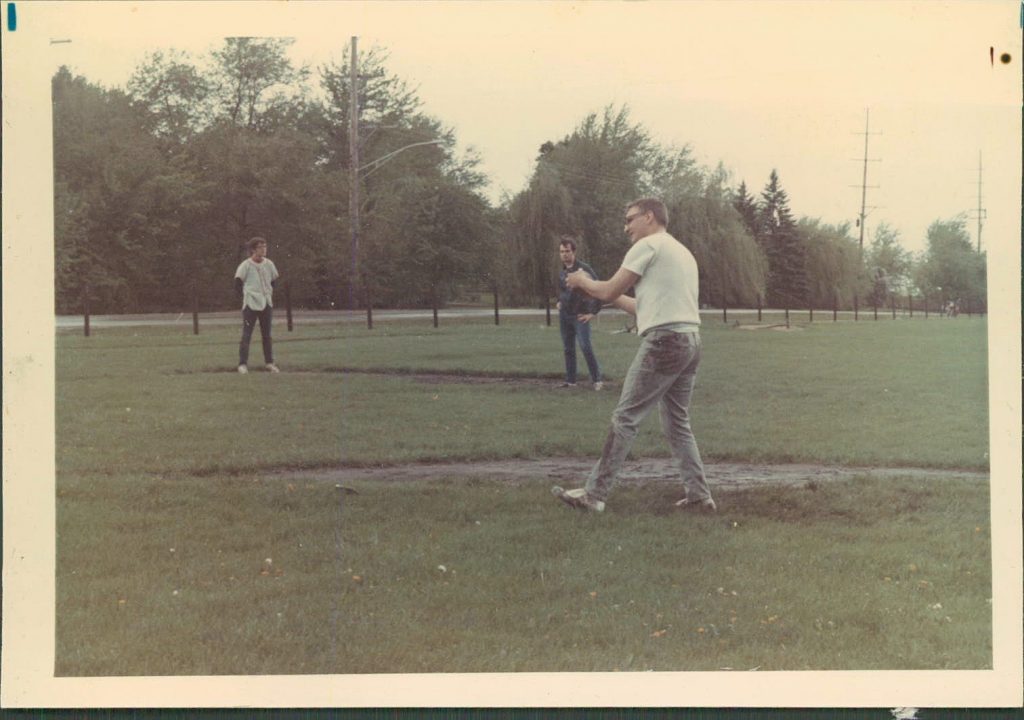
Another local, Sigma Delta Phi, would be eligible in October. John suggested that a contact be made with Sigma Delta Phi in the fall. In September 1966, The Grand Chapter received a letter from James Bloom, a Phi Sig from the Southern Illinois University chapter who had transferred to NIU. He was strongly interested in establishing a Phi Sig chapter at NIU, and asked if he could be helpful. Bert Brown and Bob Friend both responded to Jim, thanking him for offering his assistance, and cautioning that nothing be done to violate the expansion rules of the NIU administration. With that stipulation, Jim was encouraged to get to know members of eligible local fraternities. In the next several weeks, Jim informed Bob Friend that he had gotten to know members of Phi Delta Chi and Sigma Tau Sigma. The latter group seemed ready for serious contact, and Jim was sent materials to give to them. In the meantime, the Grand Chapter asked the NIU administration for formal approval to pursue talks on affiliation with NIU local fraternities.
On November 8, 1966, Dean Tamte wrote to inform Phi Sigma Kappa that it was approved “for possible establishment of a chapter on the Northern Illinois campus.” Jim Bloom then arranged for Bob Friend to meet the men of Sigma Tau Sigma at 9 PM on November 28th. In the fall of 1966, the young Sigma Delta Phi fraternity, still on probationary status, arranged to live on one floor of a private dormitory, Student House, located across Lincoln Highway at the corner of Lincoln and Glidden. Community living was something new for the group, and they didn’t yet understand the responsibility that went with it. By Christmas time, the dorm floor showed more than the normal signs of wear and tear, and the landlord decided that they should move elsewhere and pay for the damages they had caused. During the same semester, however, some more constructive thoughts occupied the minds of the members—particularly in terms of their long-term survival. They began looking into the possibility of becoming part of a national fraternity. Gary Conti chaired the committee gathering information, and letters were sent to several fraternities that appeared to be acceptable to both Sigma Delta Phi and the campus administration.
One of these fraternities was Phi Sigma Kappa. In a December letter, Gary asked if Phi Sigma Kappa would send a representative to meet with the men of Sigma Delta Phi. In the letter, he outlined the accomplishments of the local fraternity in the short time they had been in existence. They had entered a homecoming float in the competition in 1965, and their homecoming queen candidate had won the contest. In February 1966, the group won IFC scholarship trophies for the highest overall fraternity GPA and the highest overall pledge class average. They participated in Winter Carnival, and in the Greek Week Chariot Races, winning a trophy for the most beautiful chariot. They entered teams in May Fete competitions, and their 1966 homecoming queen candidate made the finals. The fraternity’s homecoming float was the winner of the President’s trophy for being the float most appropriate to the homecoming theme. They had fielded a number of athletic teams, and had grown to forty-one men. Bert Brown responded quickly, sending Sigma Delta Phi information on the national fraternity. After the holidays, Gary Conti wrote again asking for a representative to visit in March, and Bert answered that he would arrange it. In the meantime, Jim Bloom’s and Bob Friend’s contacts with Sigma Tau Sigma continued.
During the holiday break, Bert received some other interesting news. Bob Koehler, the chapter advisor at Penn State’s Kappa Chapter, wrote to tell Bert that Tony Fusaro, a University of Rhode Island initiate who had affiliated with Kappa as a Penn State graduate student, had joined the NIU political science faculty in September. Bob had learned of Phi Sig’s expansion interest at NIU, and suggested that Tony might be helpful. At this point, something needs to be said about Bert Brown. The operational management of Phi Sigma Kappa rested with him. In the Greek World, Bert was truly one of the most illustrious leaders. He had served Phi Sigma Kappa as its Grand President, Editor of the Signet, author of many of the songs published in the Phi Sig Song Book, and was eventually given the title “Mr. Phi Sig” by vote of a national convention. He had also served as President of the National Interfraternity Conference. Bert was keenly interested in expansion, but also wanted quality members. He was familiar with Tony Fusaro’s fraternity record as chapter president of both Lambda Triton and Kappa, and with his service for a time as president of both alumni groups. On January 3, 1967, he wrote: “Dear Tony: I was very much surprised and intrigued with the news that you have joined the faculty at Northern Illinois University. By a strange coincidence we are engaged in correspondence with two local fraternities at Northern Illinois and hope that we can get one of them to affiliate with Phi Sigma Kappa. . . . . . . . . . . . . . I was wondering if you would be in a position to personally investigate both of these groups, and give us your opinion. . . . . . . . . . . . . .” Fraternally, Bert Brown Contacting Sigma Tau Sigma was relatively easy, as they were living in a house very close to Tony’s apartment. A visit with some of their officers and members on a parents’ open house day was cordial, but not extremely impressive. Arranging a visit with Sigma Delta Phi turned out to be more challenging.
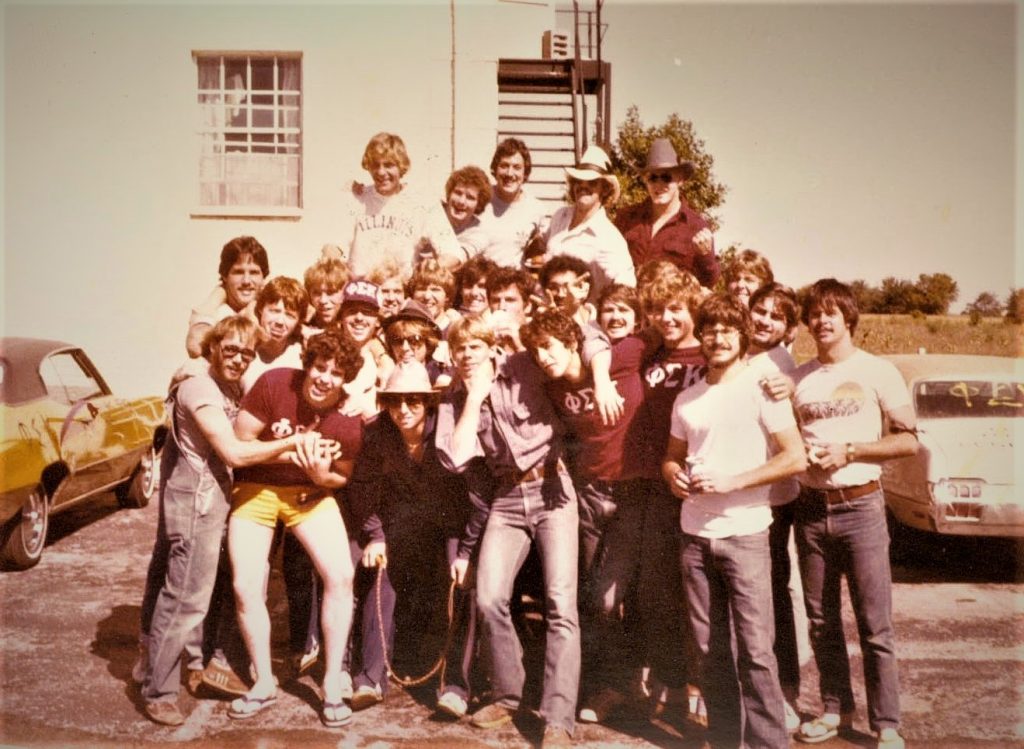
It was difficult locating them because they had moved out of Student House, and the university directory did not have a current address for them. Finally, one of the students working the desk at the University Center, mentioned the name of John Bentz, a member of the fraternity, and contact was eventually made and a visit arranged. Sigma Delta Phi had now moved into a real house at 230 Augusta, and a time was set for the group to meet with the man representing Phi Sigma Kappa. The members were told that they would be meeting with a faculty member who happened to be a Phi Sig, but they had no other details. One of the Chiquita’s, Bob Blake (known to the group as “Bozo”), said he expected to see an old absent-minded professor with the kind of stains on his pants one might associate with old age. When Dr. Fusaro arrived, to be met on the front walk by officers of the fraternity (among them Bob Blake), there was some surprise at the fact that the doddering old professor was in fact only in his late 20s, fairly trim, neatly dressed, and still with most of his hair. Likewise, Tony was impressed with the fact that he was greeted in the living room by the full membership of the fraternity, in coat and tie. As he went around the room meeting each man individually, it was immediately evident that the group possessed a spirit, which was much different than that of the first local he had met. Each man gave him a firm handshake and looked him in the eye as he introduced himself. The discussion was friendly and there was no evidence that anyone was presenting a false front just to be impressive. Coincidentally, it happened that one of the men in the group was surprised to find that the faculty member he was meeting was the same Dr. Anthony Fusaro who taught his Comparative European Politics class. Mike Prokop, from that point on, became an easy contact person for maintaining communications between Phi Sigma Kappa and Sigma Delta Phi.
That first meeting was also significant in one other respect. Bozo, while pleased to find that Phi Sig’s man on campus was relatively young, still thought that an appropriately friendly but respectful name by which to call him had to be found. He was the first to call “Doc” by the name that stuck with him from that day on. 1967 It was not difficult for Doc to make his recommendation to Bert Brown. The potential of Sigma Delta Phi, with its mature philosophy of what a fraternity should be, was far superior to that of Sigma Tau Sigma, which had already become known for its athletic success, but showed less understanding of what a true fraternity was. Bert arranged for Bob Friend to meet with Sigma Delta Phi on March 11, 1967 to make the formal presentation regarding membership in Phi Sigma Kappa. Sigma Delta Phi was acceptable to Phi Sig, and now it was up to the local to decide whether to accept the terms of membership. After a spirited discussion of the alternatives available to it, it was finally decided that Sigma Delta Phi would petition Phi Sigma Kappa for colony status. During that same weekend, Bob Friend also made a formal presentation to the members of Sigma Tau Sigma. On March 13, 1967, Gary Conti wrote to Bert Brown informing him that Sigma Delta Phi had unanimously voted to ask for membership in Phi Sigma Kappa, and that if colony status should be granted, that Dr. Anthony Fusaro be appointed their official advisor.
Doc had continued his contacts with both Sigma Tau Sigma and Sigma Delta Phi in the weeks prior to Bob Friend’s visit. Sigma Delta Phi had been especially interested in forging a closer tie, and had invited Doc to meetings, including one with their new pledge class following campus rush. He had also been asked to chaperone a party at their house—a requirement of the university at the time. While at the party, he had occasion to meet the owners of the rented house, who expressed their positive feelings about the fraternity. They mentioned that the group they had previously rented to had nearly wrecked the place. Interestingly, that group happened to be Sigma Tau Sigma. Jim Bloom’s contacts had been primarily with Sigma Tau Sigma, and following Bob Friend’s visit, they asked for discussions to continue until the group would eventually decide on national affiliation. When Bob, Jim, and Doc compared notes on the two groups, however, all agreed that Sigma Delta Phi was the better match for Phi Sigma Kappa. Sigma Tau Sigma was informed that Sigma Delta Phi had requested affiliation, and that Phi Sigma Kappa would grant it. Curiously, one of the other national fraternities Sigma Delta Phi had contacted, and that had shown interest in the group, had also been contacted by Sigma Tau Sigma, which eventually became a colony of that group, Phi Kappa Sigma.
On March 29, 1967, Phi Sigma Kappa officially notified Sigma Delta Phi that their petition was approved. University recognition of the proposed affiliation of Sigma Delta Phi with Phi Sigma Kappa was then requested in a letter from Assistant Executive Director Bob Friend to Associate Dean of Men James Tamte. On April 10, 1967, Dean Tamte responded with a letter informing Bob that the Personnel Deans had met and decided to defer action on Sigma Delta Phi’s petition “to allow time for the adjudication of the financial disagreement between Student House and Sigma Delta Phi.” The past had come back to haunt the fraternity, but luckily the adjudication was successfully completed very soon, and on April 17, 1967, Dean Tamte wrote again to give notice of the approval of Sigma Delta Phi’s affiliation with Phi Sigma Kappa. In the letter, he stated “It is my personal belief and hope that the appearance of Phi Sigma Kappa on this campus will be a step in the direction of strengthening the University’s fraternity program and that Sigma Delta Phi’s affiliation with Phi Sigma Kappa will be a positive and productive one throughout the ensuing years.” History has proven that to be a prophetic statement. Next on the agenda was organizing a membership education program to prepare Sigma Delta Phi for initiation into Phi Sigma Kappa. The group needed someone to assume the role of Inductor, and also someone to be their advisor. In the former case, James Bloom, the Phi Sig transfer from the Southern Illinois University chapter, volunteered to become the membership trainer.
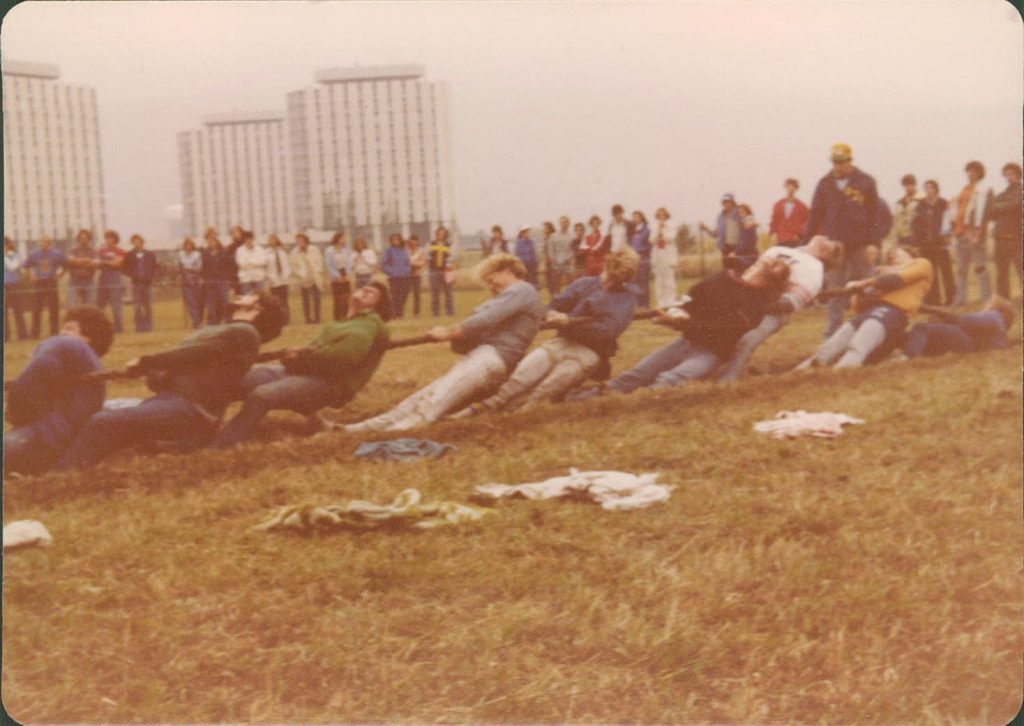
Doc was asked to be both the faculty advisor to satisfy university requirements, and colony advisor to meet Phi Sig requirements. Very soon after receiving university approval, the Ritual of Association was conducted for 43 men, led by Doc, Jim Bloom, Phi Sig District Governor Bill Aaron, and another NIU faculty member, Earth Sciences Professor, Dan Dillman, who had been discovered to be a Phi Sig. The education program began immediately. Doc had already begun attending Sigma Delta Phi meetings. In a fraternal gesture, the local fraternity had offered to initiate Doc into their group, which he accepted. It made his role in their meetings more meaningful to them prior to their initiation into Phi Sigma Kappa, and also made it clear to Doc how the organization had to change to become a chapter of Phi Sig. Not being a supporter of long pledge programs, Doc asked the men how quickly they wished to progress from colony to chapter. Theoretically, it was possible to complete a pledge program in four weeks, but that was not practical in this case. Summer was fast approaching, and much had to be done to change the group’s structure and by-laws to conform to Phi Sig standards. On the other hand, it seemed quite possible to plan for an induction relatively early in the fall semester if the men were serious about it. Doc presented two alternatives to the group. They could work through the structural and by-law changes and membership education at their own pace, and be inducted as a chapter in perhaps a year or more, as was the case with most colonies; or he could tell them what had to be done, so they could do it quickly and be inducted much earlier. They chose the latter option. In relatively short order, their structure was converted to one compatible with that of a chapter of Phi Sigma Kappa, and their by-laws were re-written to conform to the governing laws of the national fraternity. A quick study of the fall calendar indicated that the weekend of October 7th seemed to be a good possibility for the induction.
The suggestion was made to Bert Brown, who had a number of discussions with Grand President Al Rudisill and Regional Vice President Dick Schwartz, who finally gave their approval to what became the shortest colonization period in the modern history of Phi Sigma Kappa. Induction weekend was memorable, with the University of Wisconsin/Milwaukee chapter providing the ritual team. In a long and busy day, 33 men led by Colony President Dave Gulbrandsen, became Phi Sigs. The chapter initiated others, who were listed as charter members, but who could not be at the induction ceremonies, later. Interestingly, Kent Foster, who had been the moving force behind the founding of Sigma Delta Phi, had left school prior to national affiliation (According to some accounts, he had spent too much time organizing the fraternity and not enough on his studies), and was not among the initiates. A second founder of Sigma Delta Phi, Richard Stevens had also graduated by that time, and chose not to return for initiation. Bert Brown, along with other national officers attended the ceremonies, and the final banquet was held in the University Center, with Assistant Dean of Men, Boy Collier, representing the university. University President Rhoten Smith would have been present, but he sent his apologies and explained in his letter to Doc that the banquet was scheduled on “ . . . the date of a night home football game with Ball State and I have invited one hundred guests to dinner and the game.” Bert Brown later sent a very appreciative letter to the new chapter commenting “The warmth of your reception of me, especially at the induction dinner, will never be forgotten. I am truly grateful for this heartwarming experience.” A not so heartwarming experience unfolded following the chapter’s induction. Jim Bloom, who had been so interested in helping to form a Phi Sig chapter at NIU, soon became a regular absentee at fraternity events.
On December 1st, Secretary Ed Kelsey informed Bert Brown that “as of November 20, 1967, Brother James Bloom, who had affiliated with us on October 7, 1967 from Kappa Tetarton, was suspended in accordance with our By-laws for his refusal to pay fines imposed because of his lack of attendance at all fraternity functions, and his general lack of interest in participation in fraternity affairs.” From that time on, all ties with Jim were severed. One would think that having just reached a major goal, which was demanding in terms of time and effort required by the colony that had now become Pi Pentaton Chapter, the group would opt to take a break. Instead, discussion began soon after about where the permanent home of the chapter should be. The house they were now renting was not on Greek Row, even though it was very close to campus. It didn’t take long for a decision to be made that the place to be was north of the campus where most other fraternities and sororities were located. And so began the next great challenge—finding a way to buy or build a chapter home, preferably on Greek Row. 1968 As a new chapter, with no alumni organization to back it, it was obvious that support had to be found somewhere if new housing were to become a reality.
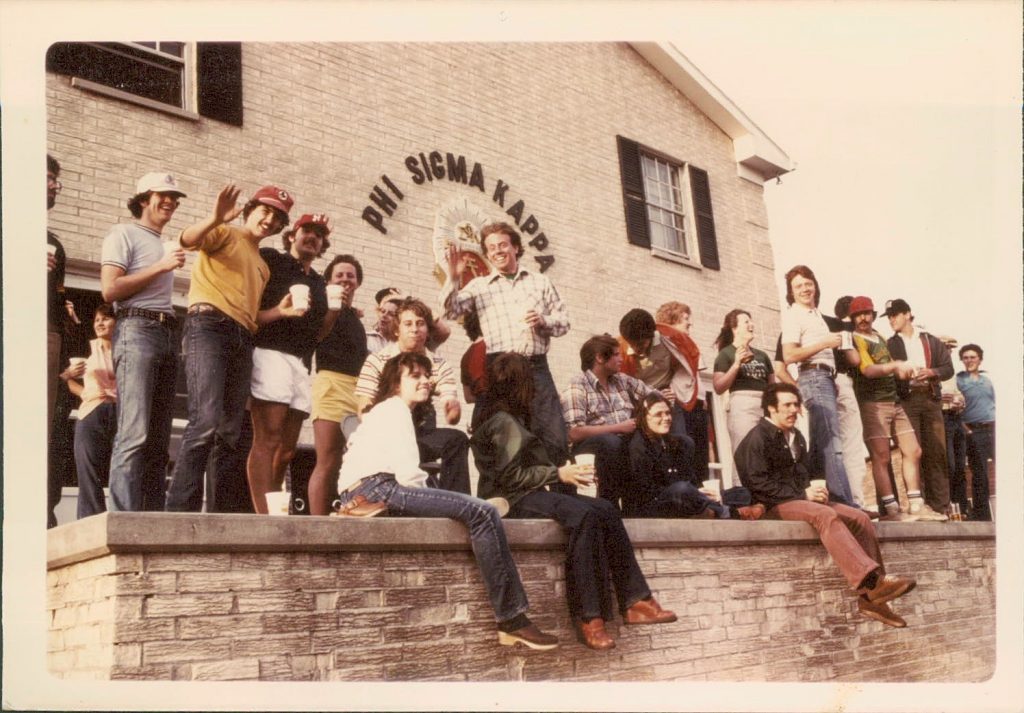
A direct bank loan was out of the question without collateral or an acceptable co-signer. The only place to look for help was within Phi Sigma Kappa itself. The Grand Chapter had in the past made loans for housing to other chapters. Maybe it would do the same for Pi Pentaton. The challenge was to make a strong enough case to convince national officers to risk a loan to a group that was less than three years old, and had only been affiliated with Phi Sigma Kappa for a few months. There were some strong arguments to be made in favor of granting a loan. First, the group had developed into a mature and stable chapter in a very short period of time, which was evidence of good leadership and a strong sense of purpose. That is not to say that there were not still some problems related to the chapter’s short history and to the usual few members who lapsed into apathy. Nevertheless, the group was already more solid than many chapters around the country, and its problems were not unmanageable. Secondly, Northern Illinois University had grown rapidly to the point of becoming the second largest central campus in the Illinois state university system, resulting in a larger demand for housing than the university could meet, and causing land prices to rise steadily. The climate for investing seemed good, but costs would apparently increase each year, making delay expensive. Although it is not possible to know precisely how it weighed in the deliberations by the Grand Chapter, another factor must also have been very important. Executive Director Bert Brown had developed a close relationship with Pi Pentaton and with Doc. He had been present at the chapter’s induction and was the guest speaker at their first Founders Day celebration. He had, of course, been made aware of the intense desire for new housing in his direct contact with chapter members and the chapter advisor, and had made his own personal observations during his visits. At some point, his comments seemed to indicate that that Grand Chapter would probably respond positively to a request for financial help.
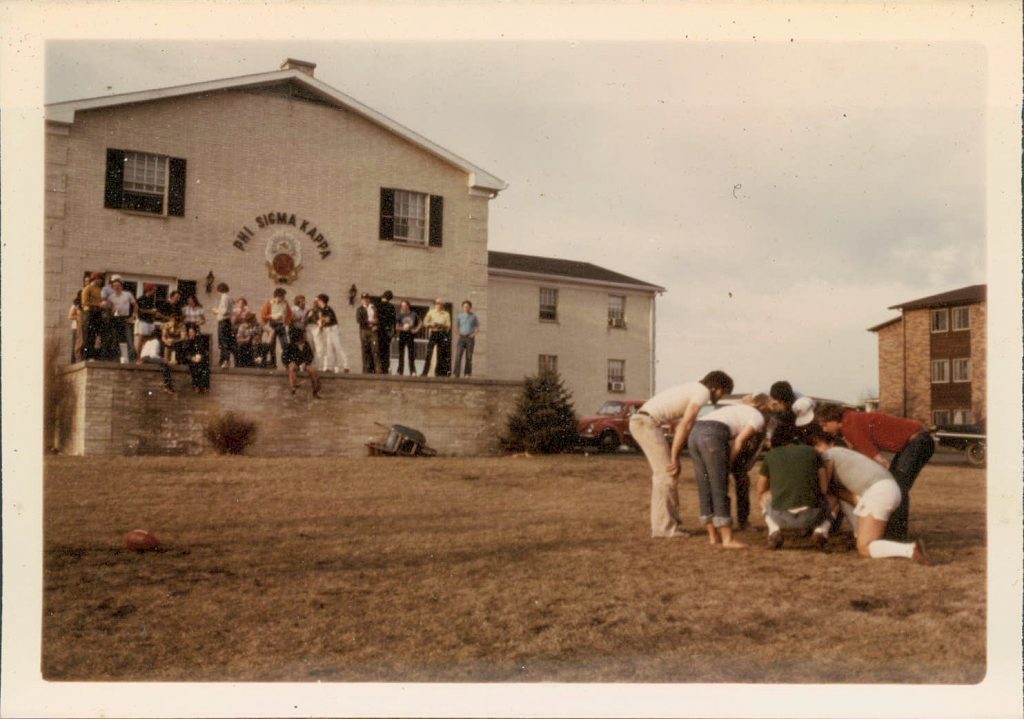
The Grand Council, of course, could only make the decision, but the definite encouragement given provided a strong moral argument in favor of assistance, and discussions continued during the rest of 1968 – 1969 The chapter members became more and more enthusiastic about acquiring a new home, and began a serious investigation of the possibilities available to it. They learned of a group of lots being developed by a contractor on Greek Row and arranged a meeting with Mr. Paul Alongi, owner of Flagg Construction Company. He appeared to be anxious to work with Phi Sigma Kappa, and offered to reserve a lot for the group while it sought financial assistance. He agreed to build a fraternity house to meet the specifications of the group, either for direct purchase or for a rent-with-option-to-buy arrangement. The alternatives were presented to the Grand Chapter, together with the financial implications of each, and the proposed chapter budget showing the chapter’s ability to shoulder the monthly payments that would be required. A meeting to discuss the options was held with Mr. Alongi on February 9, 1969. The Grand Council appeared ready to make a commitment to Pi Pentaton if a reasonable agreement with the contractor could be made. In order to get the negotiations to this point, the chapter had to demonstrate a willingness of its members to make personal commitments and sacrifices to merit the confidence of the Grand Chapter. They accomplished this in several ways. First, conservative projections of membership growth and proposed budgets indicated that the chapter would have the capacity to shoulder the financial burden of a new house. Fund raising projects resulted in the creation of a building fund, which amounted to $1500 by January of 1969, with an additional $1,000 being projected by the end of the school year. Part of the money raised came from chapter members donating the earnings from one day of laying sod for a local nursery. The chapter also contracted with the University Center to man the coatroom for one semester to earn $1600 for the building fund. In addition, pledges for donations to aid the cause over the next two years totaled approximately $1200.
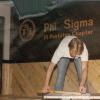
The Grand Council could not help but be impressed by the seriousness of the chapter’s efforts, and the informal commitment to help was now close to becoming a formal one. The decision was made to support a plan for building a chapter house which Pi Pentaton would rent for at least one year, after which an option to purchase could be exercised. A deposit of $10,000 would be required up front, and this would have to be provided by the Grand Chapter by way of a loan to the chapter’s alumni, who had been incorporated in 1968, with Michael Prokop as the first president. The loan would be paid back in full at seven percent interest by October 31, 1969, following the collection of the rent to be paid by those moving into the new house, which was to be completed by September 1, 1969. Mike Prokop and the chapter president, Anthony Serge, jointly signed the loan document. The chapter members had conducted a contest allowing anyone with the talent to submit a model of a proposed chapter house. The results were more than impressive. Some of the models would have done any architectural firm proud. In the end, the need for cost efficiency, practicality of design, and esthetic quality all pointed to a very attractive design by Paul Ringstrom, and it was this model, which had resulted in the cost estimates given by the contractor. The proposed chapter home would be valued at approximately $300,000.
In the meantime, Pi Pentaton settled into its home at 230 Augusta, became a full participant in campus activities, had a regular schedule of social events, and acquired a mascot St. Bernard named Herc (short for Hercules). The dog showed up one day with Brother Terry Rainey, and was, for the most part, a valued “member” of the group. Herc was an imposing creature as he grew to maturity, and strangers were not always comfortable meeting him. One day, Herc decided to nip a city meter reader trying to do his job, and it was decided that the dog needed to run free at a larger home than the fraternity could provide. Brother Rainey took upon himself the responsibility of transporting Herc to a farm where, presumably, he lived happily ever after. Construction began soon after the Grand Chapter made the down payment advance available, but there was yet one very important matter to be resolved. Where would the chapter house furniture come from? With an original capacity of 48, plus space for house parents, something had to be done quickly to find a large amount of reasonably priced furniture, and then come up with the money to pay for it. The obvious thing to do was to look to the members themselves. They discussed with the contractor the possibility of being paid to undertake some of the work, which would have to be subcontracted for during construction of the building. Mr. Alongi agreed that they could assume the responsibility of painting the inside of the house, for which he would pay them $12,000. Paul Ringstrom and Doc then began investigating the possibilities of buying furniture wholesale from Chicago and area dealers. By the time the house was ready for occupancy, every room had beds, study desks with bookcases, and desk chairs. The living room, dining room, lobby, and party room were all handsomely furnished. The house at 1300 Blackhawk was the showcase of the campus, and a new era in the history of Pi Pentaton began.
At the Augusta residence, the chapter was fortunate to have as house parents David (Soccer Coach at NIU) and Peggy Bucher. Dave had been initiated into the fraternity by the chapter, and the relationship was ideal. The couple was expecting a baby, however, and had a new house not become a reality, they would not have been able to continue as house parents because of the inadequate space at the Augusta facility. The chapter was fortunate to have them stay on for another year, and adjusted well to the new addition to their family when the baby came. When they finally left to move into their own home, the Ensalaco family, which also included a very young boy, replaced them. Bob Ensalaco was also initiated into the fraternity, and the chapter’s experience with house parents was a very positive influence on the still young group. In time, however, the university gave up the requirement that student residential organizations must have live-in supervision, and the house parents quarters were reassigned to members with seniority in the chapter. One of the first national officers to visit the chapter in its new home was Bert Brown, who attended the 1970 Founders Day celebration in March. In a letter of thanks sent to chapter president David Hernandez, he wrote in glowing terms of the “dedicated members who openly show their intense pride in the chapter and the house,” and encouraged them to meet the challenges which would inevitably confront them in the future. His very positive attitude toward Pi Pent continued to be extremely important, because the chapter and alumni, having begun the rental contract with the contractor, were already seeking support to exercise the option to purchase the property after the first year.
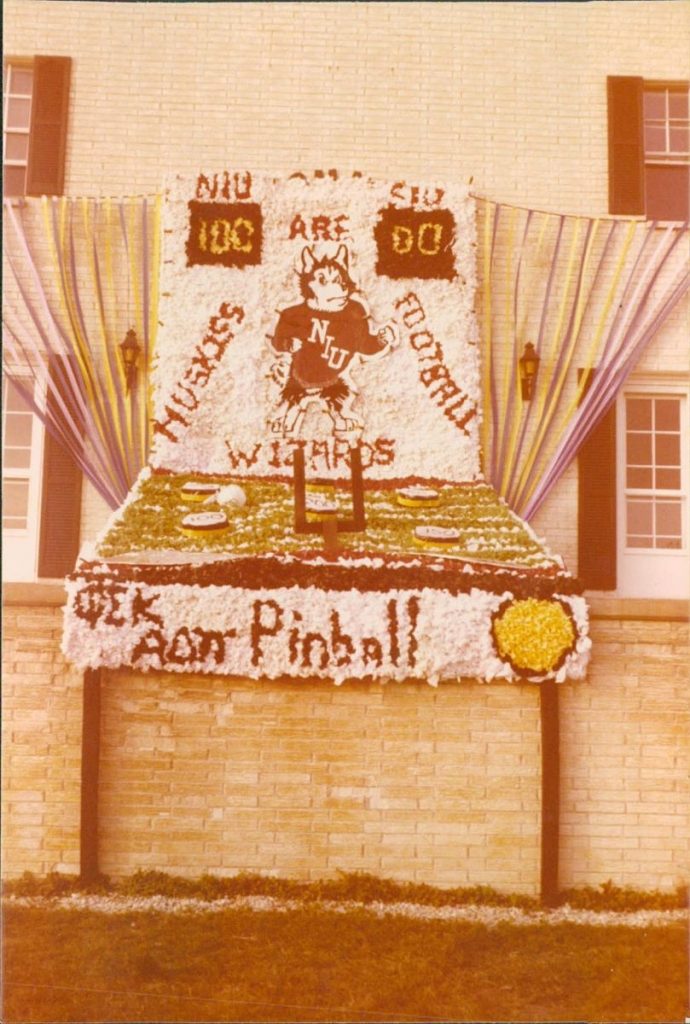
This would require a loan of approximately $30,000 from the Grand Chapter to cover the down payment on a contract purchase. Shortly after Bert’s visit, on April 1, 1970, Executive Director Leon Alexander (Bert had relinquished that position to become Editor and Business Manager of the Signet) wrote the following to chapter president Hernandez: “The Executive Committee is currently considering your request for the purchase of the Pi Pentaton house and I am certain we will hear quite shortly the results of their deliberations. I am continually amazed at the vitality of such a young chapter and the very positive direction you are setting. I hope you will forgive me if I continue to use Pi Pentaton Chapter as an example of what a young chapter with aggressive leadership . . .can do in a very short number of years.” In spite of the optimism about the chapter and its future, the decision on the requested loan was not made in 1970. On April 22, 1971, Regional Vice President Bill Aaron wrote to Grand President Robert Carter stating that among the items he “would like the Executive Committee to consider at the April meeting is the status of the loan to the Pi Pentaton Chapter for the down payment on the chapter house. As you and the other members of the committee know, we have a strong moral obligation to go through with the down payment loan which was verbally agreed to two years ago.” At the meeting, there was recognition that a moral commitment had in fact been made. However, the Grand Chapter did not have sufficient assets to tie up the required amount of funds in a direct loan. From that point on, the issue was not whether the loan should be made, but how it could be. In May, the Executive Committee met in Knoxville, Tennessee, and requested that three appraisals of the Pi Pent property be submitted. At the same time, discussions were held with officials of the First National Bank in DeKalb, which showed interest in participating in a loan arrangement.
The appraisals were submitted and indicated that the contract purchase price of $303,000 was reasonable. The Grand Chapter agreed to purchase a certificate of deposit at the bank in the amount of $33,000 earning 5 ¾% interest. This CD would be held by the bank as a pledge to guarantee the bank’s loan of $33,000 to the Pi Pentaton alumni corporation at 7 ½% payable to the bank over a ten-year period. The loan would cover the down payment and costs related to the purchase. All these details took several additional months to work out. On April 13, 1972, Alumni President Mike Prokop wrote to Grand Chapter Executive Director Richard Snowdon: “ The Agreement for Deed between the Grand Chapter and the Alumni Corporation, as well as all the other papers for the purchase of the Pi Pentaton house, were signed and sealed on March 19 and sent to our attorney for delivery. They should be at your office by now, so there’s not much left for us to do except sit back and make our monthly payments.” Taking on that financial responsibility was no small matter, for it included not only monthly payments to the bank for the down payment loan, and to the contractor for the contract mortgage, but also payments for taxes, utilities, major maintenance, and any future capital improvements which would be required. The alumni and chapter both proved worthy of the challenge. The house was fully occupied or nearly so throughout the early years, and the exercise of fiscal responsibility by both groups would result in the timely retirement of first the down payment loan and later of the mortgage, which was ceremoniously burned at the 25th anniversary celebration of the chapter in 1992.
The chapter experienced high and low points during its infancy, and although the problems often seemed great to Pi Pents, they were in fact rather normal kinds of concerns, and much less serious than other groups faced. In time, and with a little effort and patience, the challenges were overcome, and the expectations of many national officers that Pi Pentaton would become one of Phi Sig’s best were realized. The chapter was recognized regularly at Grand Chapter leadership schools and conventions with best chapter awards, and received a host of other awards as time passed in almost every area of chapter operations. Its reputation continued to grow as the chapter to visit if you wanted to see the best. In December 1995, Grand President Chuck Loring wrote to express his feelings following his visit earlier that month. “Your chapter will always remain as one of my very favorites and I can honestly say it is one of Phi Sig’s best!! My only regret on visiting Pi Pentaton was that I had to leave.” The chapter and its alumni not only earned recognition for their local operations, but also contributed to the Grand Chapter by providing guidance to other chapters by their own examples of success. In addition, several men associated with the chapter assumed leadership roles in Phi Sigma Kappa. In the fall of 1967, Bert Brown, having announced his retirement as Executive Director as of September 1968, wrote to inform Doc that his name had been placed in the hopper as a possible replacement, and asked if he was interested in being considered. Doc responded that he had just recently begun his university career, and did not think it wise to switch gears so soon. He did subsequently accept appointment as a District Governor, and in l969 became a Trustee of the Phi Sigma Kappa Foundation.
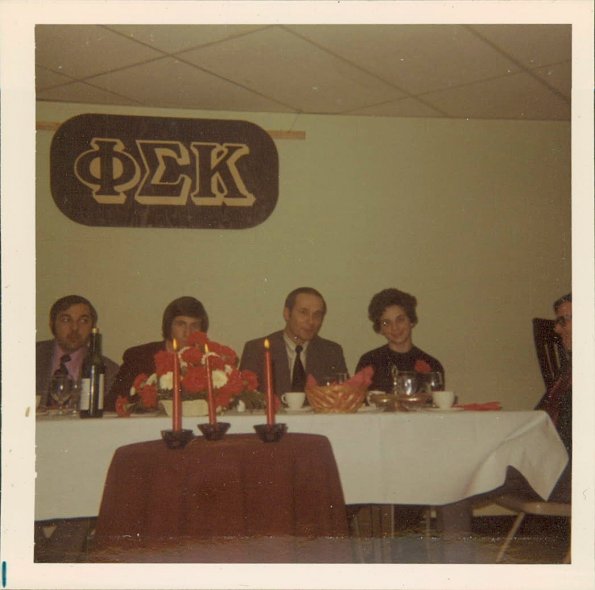
In the mid-70s, Paul Ringstrom became Regional Vice President and a member of the Grand Council. Another Pi Pent, Barry Caponi, was hired as Executive Director, and with Grand President Chuck Loring, executed the important move of the Grand Chapter headquarters from Drexel Hill, Pennsylvania to Indianapolis. In 1977, Doc was elected to the Grand Council and also that year received Phi Sig’s highest award, the Medallion of Merit. In l983, he succeeded Al Shonk as Grand President, and served until 1987, after which he became Chancellor of the Court of Honor. In the fall of 1990, he was asked by the Grand Council to complete the term of Grand President Dru Bagwell, who resigned for health reasons. In 1995, he succeeded Al Shonk as President of the Phi Sigma Kappa Foundation. Other Pi Pents served the Fraternity in a variety of roles, including Brother Bruce Peters, appointed for a time as Grand Chapter Alumni Chairman; Ken Green, Trustee of the Phi Sigma Kappa Foundation and member of the Signet Publishing Board; Greg Johnson and Glenn Roby both served as District Governor; and a number of others who have served as leadership school faculty members and committee members. One Pi Pent national officer is of special significance. Tom Lisinski, who served the chapter very devotedly as an undergraduate and as alumni president, was also appointed to serve as Province President. With great sadness, in December 1986, the fraternity said farewell to Tom as he lost his battle with cancer and became the first Pi Pent to enter the Chapter Eternal. In 1990, Doc left NIU to become head of the Abington, Pa. Branch campus of Penn State. Ken Green was appointed the new chapter advisor. A few years later, three alumni replaced the single advisor system, each assuming responsibility for different areas of chapter operations. Brothers David Niemi, John Sheehan, Pat Murphy, Frank Perez, Jeff Valentine, and James Cavanagh are among those who have accepted responsibilities in this group since the advisor team was formed. In 2000, Carl Williamson was added to the team as a local on-campus advisor. In 2001 Glenn Roby became a member of the Grand Council and in 2003 he became a founding member and the first President of the third PSK National Organization…Phi Sigma Kappa Properties a national housing corporation. In 2008 Paul Grane became the 1st Vice president of the Phi Sigma Kappa Foundation and later became its President. Carl Williamson retired as chapter advisor in 2004 and Glenn Roby was appointed to serve in that role. UPDATE: John Sheehan served the PSK Foundation as its President and Jeff Liesendahl current sits on the Grand Council as a Director. The long string of annual awards taken back to the chapter from Grand Chapter leadership schools and conventions ended in the 1990s for a time, as Pi Pentaton experienced the kind of down period that has affected many chapters over time.
The seeds of success were still there, however, and the alumni corporation, recognized as the finest in the nation, continued to provide leadership and assistance. It continued to arrange for annual capital maintenance and improvements, thus assuring that the property would not only retain its value, but increase in worth. In 1999, the work of both chapter leaders and alumni appeared to pay off. The chapter strength improved with better membership recruitment, Pi Pent was ranked among the top chapters on campus in scholarship, and it was again recognized in several areas of operations at the Grand Chapter Convention in Scottsdale, Arizona. In 2001 the Pi Pentaton chapter was again awarded for is overall excellence and received the outstanding chapter award from the Grand Chapter. The next challenge the chapter will face, and will undoubtedly conquer, is the transition to a 21st Century fraternity. A changing society, rapid technological innovation, and new trends in education will require new attitudes on the part of university administrations and the Greek systems on their campuses. Pi Pentaton and Phi Sigma Kappa will surely be leaders in the quest to “reach for the star.”